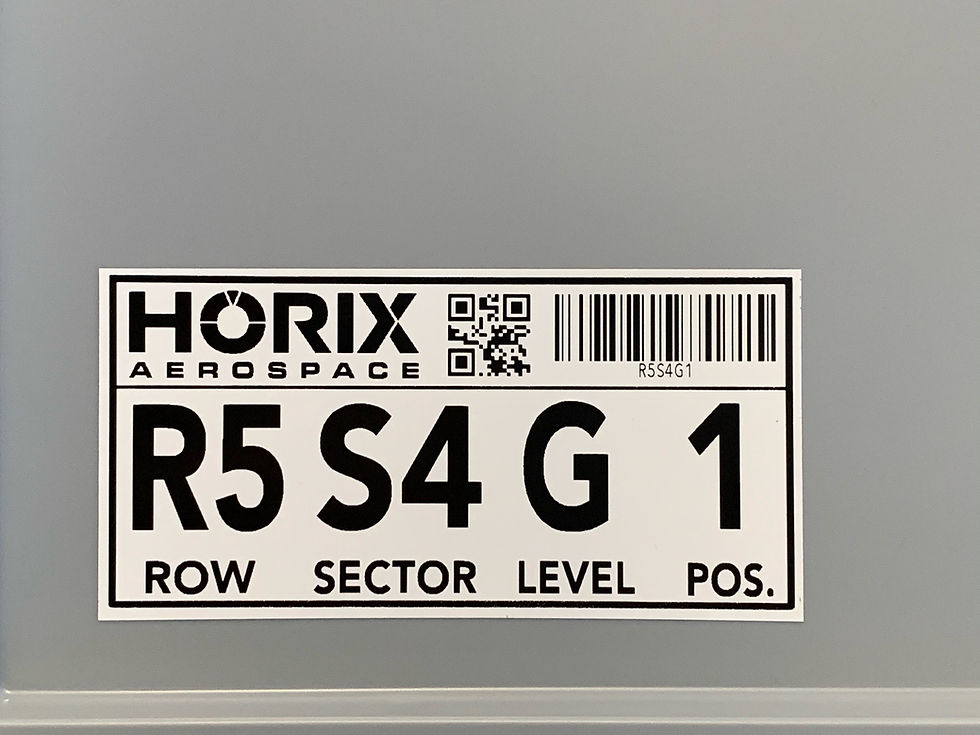The organization of a warehouse is necessary for the correct conservation of the parts and mainly to quickly find the parts you are searching for. Not finding the part we are looking for can lead to economic losses such as delays in orders or a missed sale.

It doesn't matter if it is the warehouse of a small MRO (Maintenance, Repair & Overhaul) that repairs General Aviation aircraft or the warehouse of a big OEM (Original Equipment Manufacturer), to find what you are looking for you have to organize the warehouse with the same standards.
In addition, MROs, OEMs or distributors need to handle oversized parts (such as large wooden crates for the storage of structural parts), which means having the right structure and equipment like counterbalanced forklifts with long forks, side loaders or multi-directional forklifts.


To find the parts you are looking for you need to identify the shelves correctly and for this process there is only one method that works. Over the years we have seen perfectly functioning warehouses but also warehouses with complex procedures and incorrect assigned positions.

Before starting to assign a location numbering system you will need to decide how many segments you want your location code to be. For example, you can have a location with multiple segments such as:
Warehouse
A company can manage several warehouses with a single ERP system, so even the warehouses can be coded, for example ZRH for the Zurich warehouse or MUC for the Munich warehouse.
Zone or Area
Should be used to identify an area of the warehouse distinctly different from another. For example Pallet Rack area versus Small Parts Area.
Row
Each row should be identified with a number. If you have more than 9 rows then start your number with 01. This will give you up to 99 rows. If you have over 99 rows start your numbering with 001 for a max of 999 rows.
Sector
This is defined as an area between rack uprights. Some use the term Bay instead of Sector. Select the conventional entry of the aisle and assign numbers to the racks beginning with 01 in ascending order with odd numbers on the left side and even numbers on the right side.
Level or shelf
Should be assigned and address from A to Z ascending from the floor. It is recommended to use the letters of the alphabet to identify levels so that you can recognize that it is a level.
It is also unlikely that there is a warehouse with more than 26 levels as the number of letters available.
Position
Assign numbers to each position ascending from 1 to 9, from left to right as you face the rack. Here is an example of a location label where the format is Row - Sector - Level/Position. In this case, Row R5, Sector S4, Level/Position G1.
It is recommended to combine the Level and the Position on the shelf in a single code, for example B3 or H2.

Now that the divisions have been established, it’s time to choose the type of shelving. For example, we use a pallet rack for pallet-sized bulky goods and a smaller rack for small parts.
While pallet racking is standard almost everywhere in the world, small racking comes in different sizes. Shelves depths go from 40 to 100 cm, at least in Europe.
A Standard EPAL pallet measures 120 x 80 cm. This is the starting point for figuring out what kind of shelving you need; to optimize the space, you must calculate how many boxes can fit on an EPAL: while a 50x70 cm box is not ideal for a 120 x 80 cm pallet, a 60 x 40 cm box is just perfect.
We have chosen shelves with a depth of 60 cm for this exact reason.
The width is an additional question mark. 3 boxes 40 cm wide are 120 cm in total, in fact there are plenty of 120 cm wide shelves on the market. Problem: How to fit 3 boxes 120 cm wide into a 120 cm shelf? Practically impossible, as there’s no margin.
Some smart manufacturers have made 123 cm wide shelves. It seems simple, but only few manufacturers think about it.

Our shelves are manufactured by Mobilrot, a South Tyrolean company located in the heart of the Italian Alps.

Each company chooses how to arrange material on the shelves based on the type of goods they handle. For example, we use 60 x 40 cm plastic boxes, as we mainly deal with small parts. We tested a number of different manufacturers, and after years of testing the choice fell on the German manufacturer Auer, which produces plastic boxes primarily for the German automotive industry.
We have basically two heights, 17 cm and 32 cm. There are many others available, but we have found a perfect balance with these two sizes, especially since 2 stacked 17-cm boxes are as tall as one 32-cm box.

When we visit our customers warehouses we notice that open boxes on the short side are often used. We feel that they are totally unsuitable for aviation, "stealing" warehouse space.

With our particular shelving and box system, we achieved a volumetric utilization factor of 60%, calculated as the ratio of the volume occupied by shelves VS. the volume occupied by material.
We always recommend using standard sizes as much as possible, in order to be flexible and ensure a long life for your warehouse!
Need assistance to build or renovate your Aviation Warehouse? The Horix Aerospace logistics team is available to help you manage your aviation components. Contact us today by filling out the contact form.

Comments